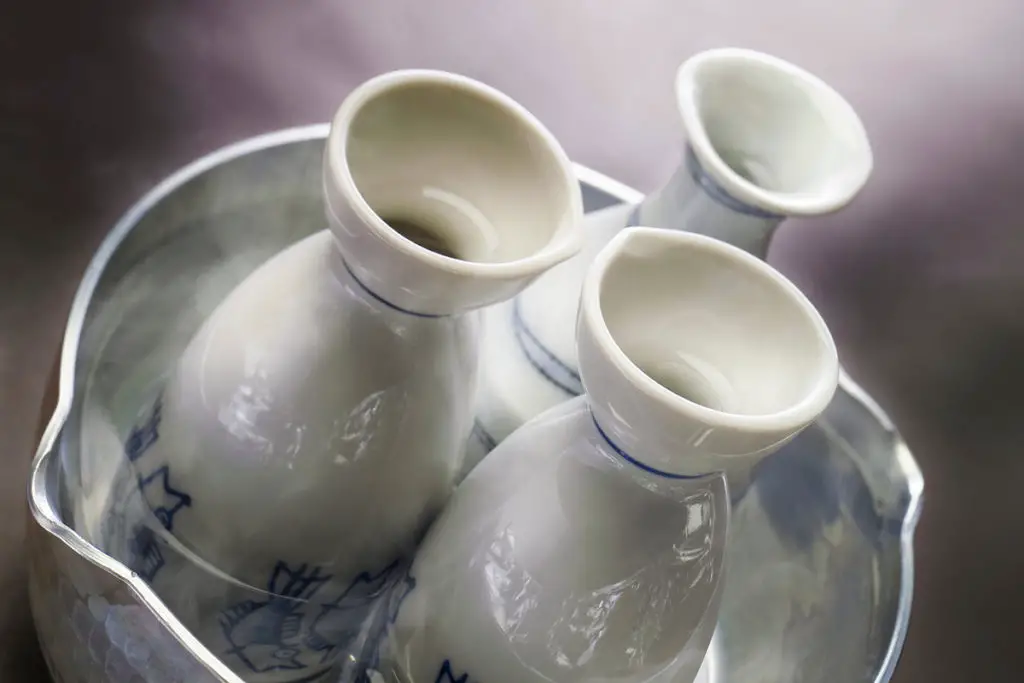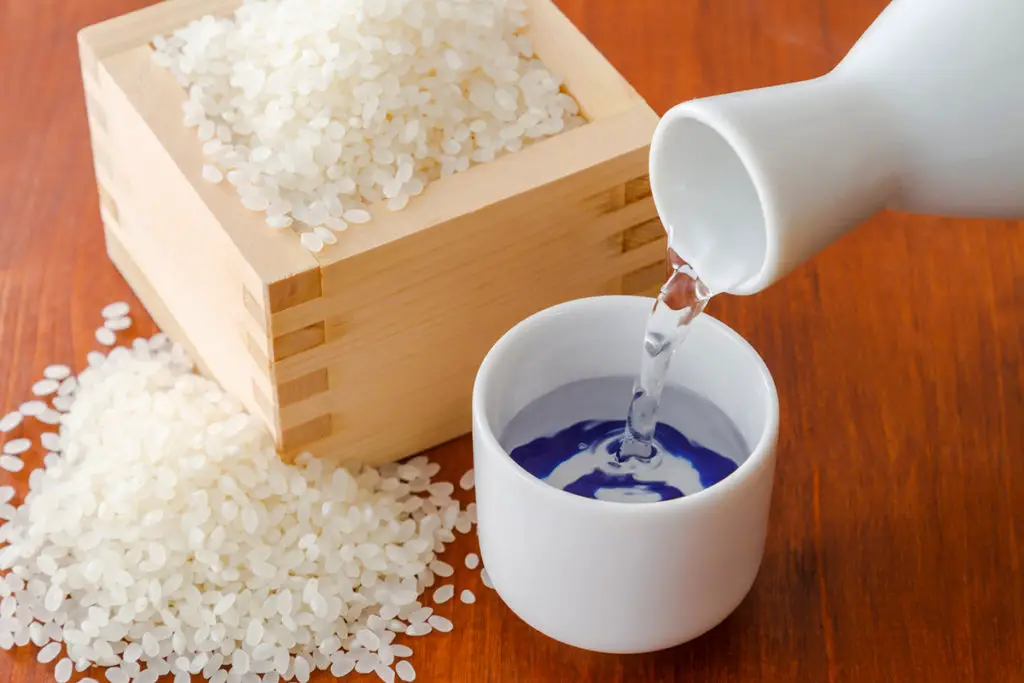Traditional Japanese rice alcohol known as Sake has a rich history that dates back to at least 300 BC. It’s the national beverage in Japan, and its rich history and importance mean that there’s a traditional way to serve and drink it.
Sake is traditionally heated in a warm water bath. Microwaving isn’t recommended because you cannot control the temperature and the heating is uneven. Sake is usually served warm because warming allows its natural flavors to blossom. However, you can also serve it chilled or at room temperature.
In this article, I’ll explain the proper way to heat sake in greater detail. Additionally, I’ll also explain why sake is served warm and when you can serve it chilled or at room temperature.
How To Heat Sake
As mentioned above, the traditional way to heat sake is to use a warm water bath. This warming sake method allows you to control the temperature of the drink.

Shaker & Spoon - We bring the bar to you! It's the perfect home happy hour🍸→ Get Your Drink Box
Being able to control your sake’s temperature is important because as the temperature changes, so does the drink’s flavor. In fact, a temperature difference as small as 5°C (41°F) can change the flavor significantly. The Japanese gradation scale for serving sake has a specific name for sake served at each 5°C (41°F) temperature variation.
Sake can be heated to as much as 60°C (140°F), though heating it so much is rarely recommended. Sake at such high serving temperatures can negatively affect the drink’s flavor and taste. Heated sake is usually served at 50°C (122°F).
Sake served at 50°C (122°F) is known as atsukan (hot) sake. To warm your sake to this temperature, you should:
- Pour the room temperature or cold sake into a tokkuri. A tokkuri is essentially a sake server that’s very similar to a decanter. Ideally, it should be made of either porcelain or ceramic. If you’re looking to buy a tokkuri, I recommend the No products found. from Amazon. This ceramic set includes a tokkuri, 6 sake cups, a stovetop warmer, a warming mug, and a bamboo tray. You also get a protective gift box to keep it safe.
- Place the tokkuri in a pot and fill it with cold water. The pot should be deep enough that all of the bulb of the server (where the sake is) is below the water. This will ensure that all of the sake heats evenly.
- Remove the tokkuri from the pot. Turn on the heat and start boiling the water. Take the water off the stovetop once the temperature is just under 100°C (212°F).
- Place your tokkuri in the pot immediately. Let the sake heat for about 2.5 minutes if you’re looking for atsukan sake. A good way to tell if the sake is at temperature is when you see the sake’s surface bubbling quickly.
Once heated, your sake should have a strong aroma and a crisp, dry flavor. If you’re looking to prepare sake to another temperature, the time it should spend in the water bath will change accordingly.
Without enough practice heating and serving sake, you’ll be able to “eyeball” the temperature. However, if you’re only just getting started, I recommend you use a thermometer to keep an eye on the temperature.
In most cases, a meat thermometer or frothing thermometer should do the job just fine. You may want to consider buying a new instrument just for your sake, however, so you don’t have to worry about the flavor being affected by inadvertent cross-contamination.
I recommend getting the No products found. from Amazon. This thermometer has a wide temperature range from -50°C to 300°C (-58°F to 572°F). Depending on your preference, it can switch between Celsius and Fahrenheit, and it’s made with food-grade stainless steel, so it’s completely safe to use for your sake.
Why You Should Serve Your Sake Warm
One of the major reasons sake is served warm is to mask the bitter notes that you’ll often find in cheaper alcohol brands. However, it’s not only lower-quality sake that is served warm.
Junmai sake – that is, sake considered “pure rice” alcohol, which is made with fermented rice, yeast, water, and koji – benefits enormously from being served warm. Another type of good sake that should be served warm is honjozo sake – sake that’s similar to junmai but has a small amount of distilled brewer’s alcohol added to make the flavors and the aroma smoother.

In general, the rule when serving sake warm is that the drinks that have notes of cereal and honey should be served warm, while those that are fruitier and have a higher alcohol volume should be served chilled. Additionally, some premium sake brands produce bottles that are specifically designed to be served warm.
Aside from “smoothing” out the flavor of lower-quality sakes, there are several reasons for serving (and drinking!) warm or hot sake. These include:
- As mentioned above, warming the drink allows its flavors and fragrances to blossom fully.
- Warm sake is a soothing option in the winter, especially in very cold areas.
- It’s believed that warm sake is absorbed by your body faster. This allows you to feel the effects quicker, which, in turn, provides you with more control over how much you drink (it’s easier to recognize when you’re overindulging if you can feel the effects).
- It’s tradition. The process of heating sake in a tokkuri and then serving it in sakazuki (sake cup) is the traditional way of consuming this drink, and it allows you to truly appreciate sake’s rich history.
However, as mentioned, not all sakes should be served warm. There are numerous sakes, including ginjo and daiginjo varieties, specifically designed to be served chilled.
Additionally, some “medium-quality” sakes are served at room temperature. This is common in restaurants where hot sake is not available – in such places, all sakes aside from the highest-quality bottles are served at room temperature.
Serving at room temperature does not usually detract from the drink flavor or aroma – it merely prevents it from maturing fully. However, it’s definitely becoming more common around Japan and the world, especially among people who drink sake with their meal and don’t have the time to wait for the cup to be warmed first.
Final Thoughts
Serving and drinking sake warm is traditional in Japan. Ideally, your sake should be heated in a water bath, though it is now possible to buy special “sake warming” machines. That said, you should never warm sake in a microwave, as you cannot control the temperature, and the sake is usually heated unevenly.
Sake is consumed warm for several reasons, including hiding the rough edges of lower-quality drinks and allowing the flavors and fragrances of higher-quality options to bloom completely. That said, not all sakes should be served warm, and some specifically call for being chilled before serving.
